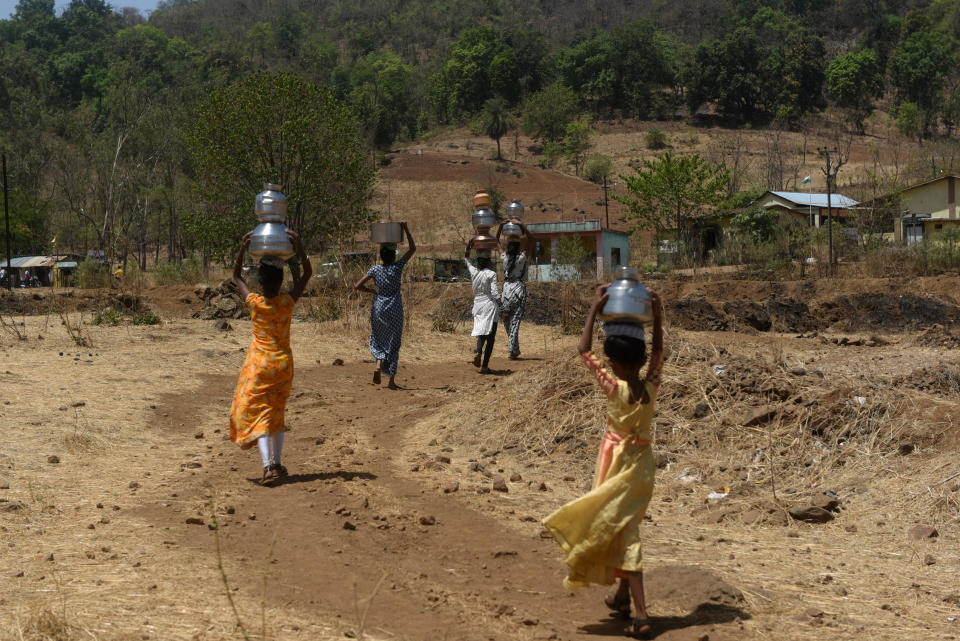New Delhi — Spring is still here but hundreds of millions of people across South and Southeast Asia have already faced scorching hot temperatures. The summer heat has arrived early, setting records and even claiming lives, and it is expected to get much worse through May and June as summer begins.
At the beginning of May, severe heat waves were already blamed for nearly three dozen deaths across the greater region. Schools have had to close weeks before the summer holidays and large numbers of new crops have failed in parched farmland.
Where the most dangerous heat is expected in the United States this summer
Scientists warn of wide-ranging impacts in some of the world’s most densely populated regions, and are urging governments to take immediate action to prepare for the impact of climate change and do everything possible to mitigate human-caused global warming .
What is happening, and where?
Several parts of India recorded maximum temperatures of over 110 degrees Fahrenheit last month. On April 21, people sweltered in the eastern city of Bagdora as the mercury touched 114.8 degrees.
The India Meteorological Department (IMD) on Tuesday issued a “red alert” warning for the eastern and southern states of Andhra Pradesh, Bihar, West Bengal and Odisha, where temperatures have been rising since mid-April. The IMD warned that the heat wave was set to get worse before it gets better.

At least two people died in the southern state of Kerala due to suspected heat stroke over the weekend. Two more deaths were blamed on the heat in the eastern state of Odisha earlier in April.
The scorching temperatures are hitting India right in the middle a six-week rolling general election — in which nearly a billion people are eligible to vote — making campaigning and voting challenging.
Authorities in neighboring Bangladesh were forced to close all schools twice in the past two weeks amid the heat wave, with temperatures soaring to nearly 110 degrees on Monday.
High temperatures of around 115 degrees have been recorded in various areas in Myanmar, and they have a much higher heat index. The heat index is a measure of what the temperature actually is feels like, taking into account humidity, wind speed and other factors.
The heat wave conditions were also brutal in Southeast Asia. In the Philippines, authorities closed thousands of schools as drought and temperatures reached 111 degrees in large areas of the country – unprecedented for the region in early April.


In Thailand, authorities have urged people to stay indoors where possible and 30 deaths have already been blamed on heat stroke this year. In the capital Bangkok, the authorities said that the heat index on Thursday was “extremely dangerous” 125.6 degrees.
In Vietnam, when the temperature exceeded the 111 degree mark, the national weather agency warned of the risk of forest fires, dehydration and heat stroke.
“Thousands of records are being brutalized across Asia, making it the most extreme event in the world’s climate history,” weather historian Maximiliano Herrera said in a post on social media last week.
What causes the extreme heat?
Scientists are divided about the impact of the ongoing El Niño weather phenomenon, but many believe that the temporary warming of the central Pacific Ocean, which has changed weather patterns around the world for decades, has made things much worse this summer in South and Southeast Asia.
“I think it is a combination of El Niño, global warming and seasonality,” said Professor Raghu Murtugude, climate scientist at the Indian Institute of Technology Mumbai, CBS News. “El Niño is transitioning to La Niña. This is the time when maximum warming occurs towards the Indian Ocean. So all these things are basically adding steroids to the weather.”
Murtuudde noted that the El Niño phenomenon was already established by March 2023, so last year’s heat waves were also due to a combination of global warming, El Niño and the annual cycle, but he said that this year worse because of the transition to the La Niña pattern.
However, not all climate scientists agree on the impact of El Niño.
“Even last year we saw heat waves and El Niño was not blamed,” Professor Krishna AchutaRao, a scientist at India’s Delhi Institute of Technology Center for Atmospheric Sciences, told CBS News.
Last year, more than 100 people were killed by intense heat waves in India and Pakistan alone in April and May, again destroying crops and affecting millions of people.
“Just like this year, last year the heat wave spread from parts of India to Bangladesh and Myanmar, and all the way to Thailand. This year it went further east, into the Philippines. So , it’s the same pattern,” AchutaRao said. “I don’t particularly buy that it’s caused by El Niño.”
Most experts agree, however, that climate change is one of the main causes of the brutal heat that hits Asia this spring, and scientists said last year. climate change was making heat waves 100 times more likely.
AchutaRao, together with other scientists working with the organization World Weather Attribution, has compiled and analyzed data on last year’s heat waves in the region and the many natural disasters that came with them in Laos and Thailand. The team” accomplished that [extreme weather] events like this would not have been possible without climate change.”
“Climate change is exacerbating the frequency and intensity of these events, severely affecting societies, economies, and, most importantly, human life and the environment in which we live,” said Ko Barrett, Deputy Secretary-General of the World Meteorological Organization last month. .
Temperatures went through the roof around the world in 2023, making the the hottest year ever recorded. The United Nations weather and climate agency said Asia was warming at a very fast pace – making extreme weather events such as floods, storms and cyclones more common. more frequent and more dangerous.
The poor will suffer the most
Around the world, countries have tried to manage the impact of extreme weather events through early warning systems and advisories, but Asia’s large, poor populations will bear the brunt of the heat waves, Murtuudde told CBS News.
The heat is likely to continue to cause widespread crop damage, further affecting the lives of farmers who have already faced mounting challenges in recent years – numbering in the hundreds of thousands. massive protests taking place in India to claim government aid.
Many national governments restrict outdoor activity to try to prevent deaths during extreme heat events, which particularly affect manual workers in the construction sector – a huge part of Asia’s fast-developing economies.
Scientists and environmental activists around the globe have consistently urged nations to reduce greenhouse gas emissions, warning that it is the only way to slow the rate of global warming. Until that happens, experts fear the death toll will continue to rise, and millions of people will face a terrible decision with each new heat wave: Work in dangerous conditions, or go to bed hungry.
Stormy Daniels’ lawyer testifies in Trump’s trial
Biden addresses campus protests over war in Gaza | Special Report
Prosecutors are urging a judge to punish Trump for further violations of the gag order